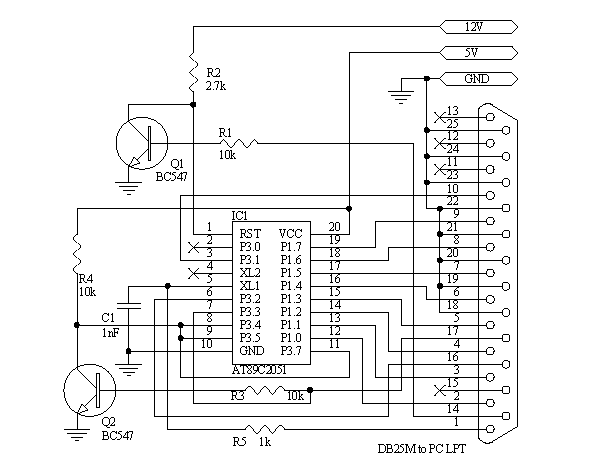At89c2051 Programming Software
понедельник 15 апреля admin 74
Easy1 Easy-Downloader V1.1 for ATMEL 89C2051/4051 Wichit Sirichote, Free schematic and software for building your own a programmer for writing intel-HEX file to the AT89C2051 and AT89C4051 WARRANTY:Easy-Downloader was designed for students, hobbyists, academic instructors to build a low-cost tool for building microcontroller circuit based on the 2051 and 4051 chips. The circuit is not professional designed, no complicated components, simple software. The beta version both writer.c and ez.exe have launched for free.
But i want to change the software on a AT89C2051 wich contains an 'HORLOGE 7 segm Program '. I know it is a very old MCU, but that is.
The author is not warrant that the circuit and software will be foolproof. Introduction The first version of the Easy-Downloader was designed in 1997 to be used as a tool for my students on building her/his own microcontrollers circuit in the class ' Designing Microprocessors System'.
The circuit features low-cost and easy use. The latest version V1.1 was designed to be used with 2051 and the newest 4051 chips. There is no separated functions like other programmer e.g., blank check, erase, write. Simply type say, c:.>ez hello, the hex file 'hello.hex' will then be programmed to the chip automatically. If the chip is not blank or the code is locked, it will erase first, then write and verify.
PCB file included Hardware Figure 1 depicts a circuit diagram of the Easy-Downloader. As shown, the circuit uses a 89C2051 with writer.hex firmware, 74LS373 8-bit latch, DS275-like, 7805, LM317 and two transistors, 2N2222A and 2N2907A. The programming voltage control circuit is the same as recommended by ATMEL application note. It can be raised from 0V, 5V and 12V by appropriated signal from P3. The 8-bit latch, 74LS373 provides some signal for selecting the programming modes.
A byte to be programmed or read back is sent/received through P1. Incrementing address is done by pulsing a positive pulse to XTAL pin. The circuit may be built using simple point-to-point soldering with a general purpose PCB( fish's egg like PCB) or making PCB shown above, the file is Protel PCB version 2.76. The finished board should be tested without any chips; 1) +5V supply, 2) programming voltage 0V, 5V and 12V by connecting the pin that control (P3.5 and D) 2N2222A and 2N2907 to +5V and/or GND. The adapter output should be approx.
This was proven to be possible by in 1990; the decomposition makes heavy use of the and is therefore. More recently, in 2017, Andrew Marks and Spencer Unger gave a completely constructive solution using. Tarski's circle-squaring problem is the challenge, posed by in 1925, to take a in the plane, cut it into finitely many pieces, and reassemble the pieces so as to get a of equal. In particular, it is impossible to dissect a circle and make a square using pieces that could be cut with an pair of scissors (that is, having boundary). Laczkovich estimated the number of pieces in his decomposition at roughly 10 50. Luchshie tajskie lakorn s russkoj ozvuchkoj.
Figure 1: Circuit Diagram of Easy-Downloader V1.1 Software Two files that you should get are: 4,871 bytes, the intel hex file firmware for 89C2051 chip ( the actual code size is 2021 bytes) and, 20,800 bytes the uploader program run on PC, send hex file to the downloader. The original program was written in 'C'. To modify, it needs Micro C-compiler from Dunfield Development System Ontario Canada with tiny memory model.
Functional Test Use a given programmer (ready made Easy-Downloader) write the writer.hex to the 2051 chip. Put the programmed 2051 chip to the board. Invoke any communication software with 9600 baud, 8-data bit, no parity. Connect DB-9 to COM1, say, press enter key, the title 'Easy-Downloader V1.1 for ATMEL 89C2051/4051' would be appeared on the screen. Type >s2048 ( set byte counter to 2k), then without the 2051 chip in ZIF, type >r (read 2kB), on screen would show FFFFFFFFFFF. Indicating corrected wiring for P1. If you put the chip having already program inside, r command will show the hex code with the number of byte set by s command.
Try e command to erase the entire program!! Figure 2 shows example of using Xtalk program to test the board. Figure 2: Using Xtalk to test the board Now try with 'ez' the uploader program to help you more easy to write the hex file to the chip. Example of using ez is shown in Figure 3.

Figure 3: Example of using EZ program writes the writer.hex to 2051 chip Figure 4: Example of Using EZ3 and EZ3.1 Download The EZ Uploader provides a simple means of sending HEX file to the writer board. Motorola gm300 radio doctor download. To connect the board with EZ, click available COM port, COM1, say. After the EZ recognizes the chips, then click Send Hexfile, that all. Since there is no signature byte that indicates chip number and programming voltage, thus you have to choose the appropriated memory size either 2051 or 4051 manually, i.e., 2048 or 4096 respectively. Download An upgraded version of EZ3 with RAED and SAVE AS features for reading HEX code resided in the chip and save as an Intel HEX file. Easy-Downloader Tips HEX file extension Some Assembler or Compiler produce output hex file with.OBJ instead of.HEX.
The EZ needs.HEX extension, just rename it. Expensive ZIF Socket Without expensive ZIF socket, you may use an ordinary socket instead, surely many times of pulling the chips may cause the far end leg of the 2051 chip broken. My student suggests me to insert one more socket to the 2051 chip.
